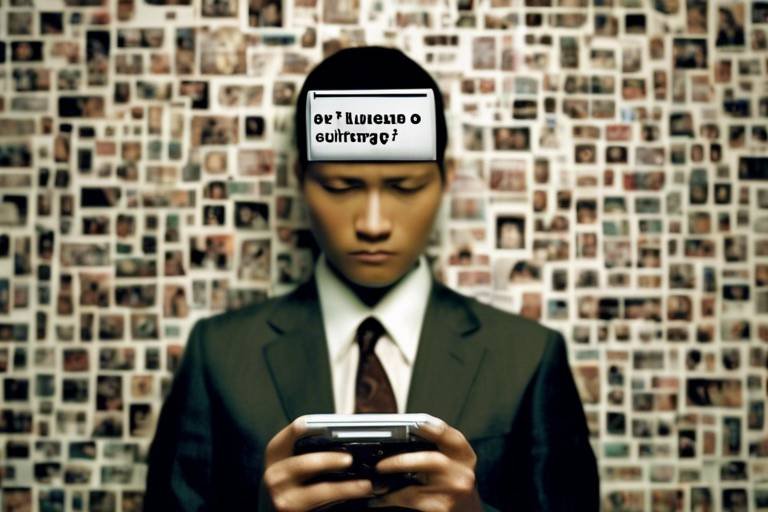How Technology is Reshaping Public Perception of Science
In today's fast-paced world, technology is not just a tool; it's a powerful catalyst that is dramatically reshaping how we view and understand science. The way we consume information has evolved, and with it, our perceptions of scientific knowledge have been transformed. Gone are the days when scientific information was confined to textbooks and academic journals. Now, platforms like social media, online education, and even the dark side of misinformation play pivotal roles in how the public engages with science. But what does this mean for our understanding of scientific truths? Are we becoming more informed, or are we just as likely to be misled by viral content? Let's dive deeper into this complex landscape.
Social media platforms have become the digital town squares of our time, where scientific information is shared, debated, and sometimes distorted. With just a click, a groundbreaking study can go viral, reaching millions within hours. This rapid dissemination of information can foster greater public engagement with science, as people from all walks of life can join the conversation. However, the democratization of knowledge also comes with challenges. The same platforms that spread valuable insights can also propagate misinformation. Think of social media as a double-edged sword: it can enlighten or confuse, depending on how it's wielded.
The rise of online education has opened the doors to scientific knowledge like never before. With platforms offering Massive Open Online Courses (MOOCs), anyone with an internet connection can access lectures from world-renowned experts. This accessibility fosters a deeper interest in science, breaking down traditional barriers that once limited learning to classrooms. Imagine being able to learn about astrophysics from a leading scientist while lounging on your couch! However, while online learning is a game-changer, it also presents its own set of challenges.
Massive Open Online Courses (MOOCs) have revolutionized how people access scientific education. Thousands can enroll in a single course, allowing for a diverse exchange of ideas and perspectives. This not only expands public interest but also encourages engagement with complex scientific topics. However, the sheer volume of available courses can be overwhelming. How do you choose the right one? And more importantly, how do you ensure the quality of the information being presented?
One of the most significant advantages of online education is the flexibility it offers. Learners can study at their own pace, accommodating various lifestyles and commitments. This flexibility enhances overall public engagement with science, as individuals can dive into topics that genuinely interest them without the pressure of a rigid schedule. Picture a busy parent who can learn about climate change during their child's nap time—this is the beauty of modern education!
Despite the myriad benefits, online learning poses challenges that cannot be overlooked. The quality of courses can vary widely, leading to potential misinformation. Moreover, the need for self-discipline is crucial; without it, learners might struggle to keep up or fully grasp complex concepts. This raises an important question: how can we ensure that online learning remains a reliable source of scientific education?
Online communities and forums have emerged as vital spaces for discussion and debate on scientific topics. These platforms allow individuals to share experiences and perspectives, significantly shaping public perception. However, the challenge lies in navigating these discussions to discern credible information from misleading narratives. It's essential to foster a culture where critical thinking is encouraged, enabling individuals to engage thoughtfully with scientific discourse.
In an age where information is abundant, the prevalence of misinformation complicates our understanding of science. False narratives can spread like wildfire, leading to confusion and a growing distrust in scientific authority. This is particularly concerning when it comes to critical issues like public health or climate change. The question looms: how can we combat this misinformation and promote a more informed public?
Teaching the public how to identify reliable scientific sources is crucial in combating misinformation. By equipping individuals with the tools to discern credible information, we empower them to make informed decisions regarding scientific issues. This could include understanding the importance of peer-reviewed studies, recognizing the difference between opinion and fact, and knowing where to find trustworthy resources. Education is our best defense against the tide of misinformation!
Fact-checking organizations play a vital role in debunking false claims and restoring trust in scientific information. By carefully evaluating the accuracy of information circulating online, these organizations help guide public perception towards more accurate understandings. Imagine having a reliable compass in a dense forest of misinformation; that's what fact-checkers provide for the public in navigating the complex world of science.
- How has social media changed the way we perceive science?
Social media has made scientific information more accessible but also more susceptible to misinformation, creating a complex landscape for public perception. - What are MOOCs and how do they benefit learners?
MOOCs are online courses that allow thousands of students to learn from experts, making scientific education more accessible and engaging. - What challenges do online learners face?
Challenges include varying course quality and the need for self-discipline, which can affect the effectiveness of science education. - How can we combat misinformation in science?
By teaching the public to identify reliable sources and supporting fact-checking organizations, we can promote informed decision-making.

The Role of Social Media
Social media platforms have become the beating heart of modern communication, acting as a bridge between scientists and the public. In today's digital age, platforms like Twitter, Facebook, and Instagram are not just for sharing personal moments; they are powerful tools for disseminating scientific information. But how exactly does this metamorphosis occur? Well, think of social media as a vast ocean of information where ideas can either sink or swim, depending on how engaging and relatable they are. With just a click, a scientific breakthrough can go viral, reaching millions and reshaping public perception almost overnight.
One of the most significant impacts of social media is its ability to democratize knowledge. Anyone with an internet connection can access scientific discussions, share their opinions, and engage with experts. This creates a more inclusive environment where diverse voices can contribute to scientific discourse. However, this democratization comes with its own set of challenges. For instance, while it's fantastic that more people can participate, it also means that misinformation can spread just as quickly as accurate information.
Moreover, the engagement factor on social media cannot be overlooked. Posts that are visually appealing or emotionally charged tend to gain traction much faster than dry, academic articles. This phenomenon leads to a scenario where the most sensationalized information often overshadows the more nuanced and factual content. To illustrate this, consider the following:
| Type of Content | Engagement Level |
|---|---|
| Infographics | High |
| Video Explainers | Very High |
| Research Articles | Low |
This table highlights how different types of content can engage audiences in varying degrees. Visual content, like infographics and videos, often garners more attention than traditional research articles. This trend begs the question: Are we sacrificing depth for the sake of engagement? The answer is complex, but it underscores the need for scientists and educators to adapt their communication strategies to leverage social media effectively.
Furthermore, social media serves as a platform for real-time discussions. During significant scientific events, such as the announcement of a new discovery or a public health crisis, social media becomes a hub for sharing information and opinions. Hashtags can help organize conversations, making it easier for users to follow along. However, this immediacy can lead to the rapid spread of unverified information, which complicates the public's understanding of scientific issues.
In conclusion, while social media has revolutionized the way we share and perceive scientific knowledge, it is a double-edged sword. The potential for widespread engagement is tempered by the risk of misinformation and sensationalism. It is crucial for both scientists and the public to navigate this landscape thoughtfully, promoting a culture of critical thinking and informed discussion. After all, in a world where information is at our fingertips, understanding how to discern fact from fiction is more important than ever.

Online Education and Accessibility
In today's fast-paced world, online education has emerged as a game-changer, fundamentally altering how we access and engage with scientific knowledge. Gone are the days when learning was confined to the walls of traditional classrooms. Now, anyone with an internet connection can dive into a wealth of resources, making science more accessible than ever before. This shift not only democratizes education but also fosters a culture of curiosity and inquiry among diverse audiences.
The rise of online platforms has opened up a treasure trove of opportunities for learners. Imagine being able to take a course from a renowned scientist in your pajamas or joining a global classroom filled with students from different countries, all eager to learn about the mysteries of the universe. This is the reality of online education, where flexibility and accessibility reign supreme. With just a few clicks, learners can explore subjects ranging from astrophysics to genetics, all while fitting their studies around their busy lives.
However, it's essential to recognize that while online education offers tremendous benefits, it also comes with its own set of challenges. The quality of courses can vary significantly, and not all platforms provide the same level of rigor or engagement. Some courses may be nothing more than a series of videos, lacking the interactive elements that enhance learning. Moreover, the responsibility often falls on the learner to stay motivated and disciplined, which can be a double-edged sword. A lack of structure might lead some to drift away from their studies, while others thrive in this environment.
To truly understand the impact of online education, we should also consider the role of Massive Open Online Courses (MOOCs). These platforms have transformed the educational landscape by allowing thousands of students to enroll in courses offered by top-tier universities and institutions. MOOCs have made it possible for anyone, regardless of their background or location, to gain access to high-quality scientific education. This not only enhances public interest in science but also cultivates a more informed society.
Furthermore, the flexibility of online courses means that learners can choose when and how they study. Whether you're a night owl or an early bird, online education accommodates your lifestyle. This adaptability is particularly beneficial for those juggling multiple responsibilities, such as work or family commitments. By providing the freedom to learn at one’s own pace, online education enhances overall public engagement with science and fosters a lifelong love of learning.
In conclusion, the rise of online education has significantly improved accessibility to scientific knowledge, breaking down traditional barriers and creating new pathways for learning. While challenges exist, the benefits far outweigh them, offering a bright future for those eager to explore the wonders of science.
- What is online education? Online education refers to learning that takes place over the internet, allowing students to access courses and materials remotely.
- How do MOOCs work? MOOCs are online courses offered by universities that are accessible to anyone with an internet connection, often free or at a low cost.
- What are the challenges of online learning? Challenges include varying course quality, the need for self-discipline, and potential feelings of isolation among learners.
- How can I find reliable online courses? Look for courses offered by accredited institutions, read reviews, and check the qualifications of the instructors.

Impact of MOOCs
Massive Open Online Courses, or MOOCs, have truly revolutionized the landscape of education, particularly in the realm of science. Imagine being able to sit in your living room and access lectures from world-renowned scientists and educators, all at the click of a button. This is not just a dream; it’s a reality that MOOCs offer. They have democratized education, making it accessible to anyone with an internet connection, regardless of geographic location or socioeconomic status. This accessibility has led to a significant increase in public interest in scientific topics, as people from all walks of life can engage with content that was once reserved for those in formal educational settings.
One of the most exciting aspects of MOOCs is their ability to cater to a vast audience. These courses often attract thousands of learners simultaneously, creating a unique environment where individuals can learn together, share ideas, and collaborate on projects. The interactive nature of many MOOCs encourages students to participate actively, fostering a sense of community among learners who might never have met otherwise. This interaction not only enhances the learning experience but also allows for the exchange of diverse perspectives, which can enrich the understanding of complex scientific concepts.
Moreover, MOOCs are often designed by leading institutions and feature high-quality content. For instance, platforms like Coursera, edX, and FutureLearn bring together courses from top universities and organizations, ensuring that learners receive education that is both credible and relevant. This is particularly important in science, where staying updated with the latest research and developments is crucial. Through MOOCs, learners can access cutting-edge information and methodologies that might not be available in traditional classroom settings.
However, it’s essential to acknowledge that the impact of MOOCs is not without challenges. While they offer flexibility and convenience, the quality of courses can vary significantly. Some courses may be poorly designed or lack engaging content, which can lead to frustration and disengagement among learners. Furthermore, the self-paced nature of MOOCs requires a level of self-discipline that not everyone possesses. Without the structure of a traditional classroom, some learners may struggle to complete courses, leading to high dropout rates.
To navigate these challenges, it is crucial for learners to research and select MOOCs that have positive reviews and are offered by reputable institutions. By doing so, they can maximize their learning experience and ensure that they are receiving quality education. Additionally, learners should set personal goals and create a study schedule to maintain motivation and accountability.
In conclusion, MOOCs have had a profound impact on how the public engages with scientific education. They have opened doors to knowledge that were previously closed, allowing for a more informed and curious society. As technology continues to evolve, the potential for MOOCs to shape public perception of science will only grow, making it an exciting time for both learners and educators alike.
- What are MOOCs? MOOCs are Massive Open Online Courses that provide free or low-cost access to high-quality educational content from universities and institutions around the world.
- How do I choose a good MOOC? Look for courses offered by reputable institutions, check reviews and ratings, and ensure the course content aligns with your learning goals.
- Can I earn a certificate from a MOOC? Yes, many MOOCs offer certificates upon completion, which can be a great addition to your resume or portfolio.
- Are MOOCs suitable for everyone? While MOOCs are designed to be accessible, they require self-motivation and discipline to complete, which may not suit all learners.

Benefits of Flexible Learning
In our fast-paced world, the cannot be overstated. Imagine being able to tailor your education around your life instead of the other way around! This approach allows individuals to engage with scientific content at their own pace, making learning not just accessible but also enjoyable. Whether you're a busy professional, a parent juggling responsibilities, or someone simply looking to expand your knowledge, flexible learning provides an incredible opportunity to dive into the world of science without the constraints of a traditional classroom setting.
One of the most significant advantages of flexible learning is the ability to choose when and where you study. This flexibility means that you can pick up your studies during your lunch break, in the early hours of the morning, or late at night, depending on what suits your schedule best. This adaptability not only increases the likelihood of completing a course but also enhances retention of information, as learners can revisit challenging topics whenever they need to without the pressure of keeping up with a fixed timetable.
Moreover, flexible learning environments often utilize a variety of multimedia resources, including videos, podcasts, and interactive simulations, which cater to different learning styles. For instance, visual learners can benefit from engaging infographics, while auditory learners might prefer listening to expert discussions. This diversity in teaching methods fosters a deeper understanding of scientific concepts, making the learning experience more enriching and less monotonous.
In addition, flexible learning encourages a sense of ownership over one's education. When learners have the freedom to choose their learning paths, they are more likely to pursue topics that genuinely interest them. This intrinsic motivation can lead to a more profound and lasting engagement with science. Furthermore, many online platforms offer forums and discussion groups where learners can connect with peers, share insights, and collaborate on projects. This community aspect not only enriches the learning experience but also helps to build a network of like-minded individuals who can support each other in their scientific journeys.
However, while flexible learning has its perks, it’s essential to acknowledge that it requires a certain level of self-discipline. Without a structured environment, some learners might struggle to stay motivated or may find it challenging to manage their time effectively. To combat this, many online courses provide tools and resources to help learners stay on track, such as progress trackers and reminders. By utilizing these tools, individuals can harness the full potential of flexible learning while maintaining their commitment to their educational goals.
In summary, the benefits of flexible learning extend far beyond mere convenience. It opens doors to a world of knowledge, encourages personal growth, and fosters a community of learners eager to explore the wonders of science. As technology continues to evolve, embracing flexible learning could very well be the key to unlocking a brighter future for scientific education.
- What is flexible learning? Flexible learning refers to educational approaches that allow learners to choose when, where, and how they study, accommodating their individual needs and lifestyles.
- How can I stay motivated in a flexible learning environment? Setting personal goals, using progress trackers, and participating in online communities can help maintain motivation and accountability.
- Are there any downsides to flexible learning? While it offers many benefits, some learners may struggle with self-discipline and time management without a structured environment.
- What resources are available for flexible learning? Many online platforms provide a variety of resources, including videos, articles, quizzes, and discussion forums to enhance the learning experience.

Challenges of Online Learning
While online learning has opened up a world of opportunities for acquiring scientific knowledge, it is not without its challenges. One of the most significant hurdles is the varying quality of courses available. With a plethora of platforms and instructors, the educational experience can be inconsistent. Some courses are well-structured and provide valuable insights, while others may lack depth or clarity. This inconsistency can lead to frustration among learners who are eager to engage with science but find themselves navigating through subpar content.
Another challenge is the need for self-discipline. Unlike traditional classroom settings where instructors guide you through lessons, online learning often requires students to take the initiative. This can be daunting for many individuals, especially those who may struggle with time management or motivation. The freedom to learn at one's own pace is a double-edged sword; while it allows for flexibility, it can also result in procrastination and incomplete courses.
Additionally, the lack of direct interaction with instructors and peers can hinder the learning experience. In a physical classroom, discussions can flow naturally, and students can ask questions in real-time. Online, however, learners may feel isolated and miss out on the collaborative environment that fosters deeper understanding and engagement. This disconnect can lead to a sense of alienation, making it harder for some to stay committed to their studies.
Moreover, not all learners have equal access to technology and reliable internet connections, which can exacerbate existing inequalities in education. For those in remote areas or from underprivileged backgrounds, the dream of accessing high-quality scientific education can remain just that—a dream. This digital divide highlights the importance of addressing accessibility issues to ensure that online learning truly benefits everyone.
In summary, while online learning presents exciting opportunities for expanding public engagement with science, it is essential to acknowledge and address these challenges. By improving course quality, fostering community interaction, and ensuring equitable access to technology, we can create a more inclusive and effective online learning environment that truly empowers individuals to explore the wonders of science.
- What are the main challenges of online learning? The main challenges include varying course quality, the need for self-discipline, lack of direct interaction, and accessibility issues.
- How can I improve my self-discipline for online courses? Setting a schedule, creating a dedicated study space, and breaking tasks into smaller, manageable goals can help improve self-discipline.
- Are all online courses the same quality? No, the quality of online courses can vary significantly. It's important to research and read reviews before enrolling.
- What can be done to address the digital divide? Initiatives that provide technology access and training to underserved communities can help bridge the digital divide.

Influence of Online Communities
Online communities have emerged as vibrant hubs where individuals converge to discuss, debate, and share their thoughts on various scientific topics. These platforms, ranging from dedicated forums to social media groups, serve as a melting pot for ideas and experiences. Imagine walking into a bustling café filled with people passionately discussing the latest scientific discoveries; that’s the kind of atmosphere online communities create. They break down geographical barriers, allowing people from different backgrounds and cultures to exchange knowledge and perspectives.
One of the most significant aspects of these communities is their ability to democratize scientific discourse. Gone are the days when scientific knowledge was confined to academic circles. Now, anyone with internet access can participate in discussions, ask questions, and contribute their insights. This shift has not only increased public interest in science but has also empowered individuals to become more engaged in scientific conversations. For instance, platforms like Reddit and specialized Facebook groups are teeming with users who share articles, post questions, and provide explanations, making science more approachable and less intimidating.
However, while online communities can enhance understanding, they can also be a double-edged sword. The very same platforms that foster knowledge sharing can also propagate misinformation. For example, a viral post claiming a miraculous health benefit from a common food item can lead to widespread misconceptions. Therefore, it’s crucial for participants in these communities to develop critical thinking skills and learn how to discern credible information from dubious claims. Engagement in these communities requires a balance between sharing enthusiasm for science and maintaining a skeptical eye towards the information being circulated.
Moreover, online communities provide a space for peer support in scientific learning. Individuals who might feel isolated in their interest in science can find like-minded people who share their passions. Whether it’s a discussion about climate change, the latest in space exploration, or even the intricacies of genetic engineering, these communities allow for a collective exploration of knowledge. They encourage members to ask questions and seek clarification, fostering a culture of curiosity and continuous learning.
To highlight the impact of online communities on public perception of science, consider the following table that summarizes their key influences:
| Influence | Description |
|---|---|
| Knowledge Sharing | Facilitates the exchange of scientific information among diverse audiences. |
| Community Support | Provides emotional and intellectual support for individuals exploring scientific topics. |
| Critical Thinking | Encourages members to evaluate sources and claims critically. |
| Viral Misinformation | Can lead to the rapid spread of false information, complicating public understanding. |
In conclusion, online communities play a pivotal role in shaping public perception of science. They create spaces for dialogue, foster engagement, and enhance accessibility to scientific knowledge. However, the responsibility lies with the community members to navigate these waters wisely, ensuring that the information shared is accurate and beneficial. As we continue to engage in these vibrant discussions, let’s remember the power we hold in shaping the narrative of science in our society.
- What are online communities?
Online communities are groups of people who interact over the internet to discuss shared interests, including scientific topics.
- How do online communities influence public perception of science?
They democratize access to information, encourage discussions, and can either promote understanding or spread misinformation.
- What can I do to ensure I’m getting accurate scientific information?
Engage in critical thinking, verify sources, and participate in reputable online communities.

The Misinformation Challenge
The digital age has brought about a double-edged sword when it comes to the dissemination of scientific knowledge. On one hand, technology has made information more accessible than ever before; on the other hand, it has also paved the way for the rampant spread of misinformation. With just a few clicks, anyone can publish content that can influence public perception, often with little regard for accuracy. This situation raises a critical question: how can we discern fact from fiction in a sea of information?
One of the most concerning aspects of this misinformation challenge is the speed at which false narratives can spread. Social media platforms, which are designed for rapid sharing and virality, often amplify misleading information. For instance, a sensational headline can go viral within hours, reaching millions before a fact-checker even has the chance to respond. This phenomenon creates a situation where the public might form opinions based on incomplete or inaccurate information, leading to confusion and distrust in legitimate scientific authority.
To combat this challenge, it is essential to empower individuals with the tools to identify reliable sources of scientific information. Here are some key strategies:
- Verify the Source: Always check the credibility of the website or organization behind the information. Established institutions like universities, government agencies, and reputable scientific journals are generally reliable.
- Cross-Reference Information: Look for multiple sources that confirm the same information. If an article is the only one making a particular claim, it’s worth investigating further.
- Check for Bias: Be aware of the potential biases in the information presented. Is the author affiliated with a particular organization that might influence their perspective?
Additionally, the role of fact-checking organizations has become increasingly vital in this landscape. These organizations work tirelessly to debunk false claims and provide the public with accurate information. By scrutinizing viral content and clarifying misconceptions, they help to restore trust in scientific information. For example, organizations like Snopes and FactCheck.org have dedicated teams that specialize in verifying claims and providing context, which is crucial in guiding public perception towards more accurate understandings.
As we navigate this complex environment, it’s important to remember that the responsibility of combating misinformation lies not only with organizations but also with individuals. By fostering a culture of critical thinking and skepticism, we can empower ourselves and others to question the information we encounter daily. In doing so, we can cultivate a more informed public that values science and understands its significance in our lives.
Q1: What is misinformation?
A1: Misinformation refers to false or misleading information spread regardless of intent. It can stem from misunderstandings, misinterpretations, or outright fabrications.
Q2: How can I identify reliable scientific sources?
A2: Look for information from established institutions, check for citations, and ensure that the content is peer-reviewed or published in reputable journals.
Q3: What role do social media platforms play in spreading misinformation?
A3: Social media platforms facilitate rapid sharing of information, which can lead to the quick spread of misinformation, especially when sensational or emotionally charged content is involved.
Q4: How can I contribute to combating misinformation?
A4: You can help by sharing accurate information, fact-checking before sharing, and educating others about how to identify reliable sources.

Identifying Reliable Sources
In today's digital age, where information is just a click away, has become more crucial than ever. With the overwhelming amount of content available online, distinguishing between credible information and misinformation can feel like searching for a needle in a haystack. So, how do we navigate this complex landscape? First and foremost, it’s essential to understand that not all sources are created equal. Reliable sources typically have a few key characteristics that set them apart.
One of the most effective strategies is to consider the credentials of the author. Are they an expert in the field? Do they have relevant qualifications or experience? For instance, a scientific article written by a PhD in biology is far more trustworthy than a blog post by someone with no formal education in the subject. Additionally, look for publications that are peer-reviewed. This process ensures that other experts have evaluated the research before it is published, adding a layer of credibility.
Another critical aspect is the transparency of the source. Reliable sources often provide clear citations and references, allowing readers to trace back the information to its original context. If a website claims a scientific breakthrough but fails to link to any studies or data, it's a red flag. Furthermore, consider the motivation behind the content. Is the information being presented to inform and educate, or is it aimed at selling a product or pushing a specific agenda? Understanding the intent can help you gauge the reliability of the information.
Moreover, it’s important to cross-check information across multiple sources. If several reputable outlets report the same facts, it’s more likely to be accurate. This practice not only helps in verifying the information but also provides a broader perspective on the topic. For example, if you read about a new scientific study on climate change, checking major scientific journals or reputable news outlets can help confirm the findings.
In summary, identifying reliable sources involves a combination of evaluating the author's credentials, checking for transparency in citations, understanding the intent behind the information, and cross-referencing with other reputable sources. By honing these skills, the public can significantly improve their ability to discern fact from fiction in the vast sea of information available online.
- How can I tell if a source is credible? Look for expert authorship, peer-reviewed publications, and clear citations.
- What should I do if I find conflicting information? Cross-check with multiple reputable sources to get a clearer picture.
- Are social media sources reliable? Generally, social media should be approached with caution; always verify claims with trusted outlets.
- How can I improve my information literacy? Engage in educational resources that focus on critical thinking and media literacy skills.

The Role of Fact-Checking
In today's digital age, where information travels at lightning speed, the role of fact-checking has never been more critical. With the surge of misinformation that can easily go viral, fact-checking organizations serve as the guardians of truth, striving to sift through the noise and present the public with accurate scientific information. Imagine a vast ocean of data; fact-checkers are like skilled navigators, guiding us safely through treacherous waters filled with misleading claims and half-truths.
These organizations not only debunk false narratives but also play an essential role in restoring trust in scientific discourse. By providing thorough investigations and transparent methodologies, they help the public understand which sources are credible and which are not. For instance, when a sensational claim about a new scientific discovery circulates, fact-checkers dive deep into the research, consulting experts and reviewing studies to provide a clear and concise verdict.
Moreover, the influence of fact-checking extends beyond just correcting errors. It also fosters a culture of critical thinking. When individuals encounter a scientific claim, they are encouraged to question its validity and seek out reliable sources. This shift in mindset is crucial, as it empowers people to become more informed consumers of information, rather than passive recipients of whatever comes their way. To illustrate this, consider the following table, which outlines the impact of fact-checking on public perception:
| Impact of Fact-Checking | Examples |
|---|---|
| Increased Trust in Science | Surveys show that people who engage with fact-checked content are more likely to trust scientific institutions. |
| Improved Public Understanding | Fact-checking clarifies complex scientific topics, making them accessible to a wider audience. |
| Reduction of Misinformation Spread | Fact-checkers often highlight false claims, which can slow their viral spread. |
In addition, fact-checking organizations often collaborate with social media platforms to flag misleading content. By implementing algorithms that prioritize verified information, they help create a safer online environment for users seeking scientific knowledge. This partnership is vital, especially when considering that many individuals turn to social media as their primary source of information. However, it's essential for users to remain vigilant and actively engage in discerning the quality of the information they consume.
Ultimately, the role of fact-checking transcends mere correction; it is about fostering a more informed society. As we navigate through the complexities of scientific information in the digital landscape, we must recognize the importance of these organizations in shaping our understanding and perception of science. By championing the truth, they not only enhance public discourse but also contribute to a more scientifically literate society.
- What is fact-checking? Fact-checking is the process of verifying the accuracy of information, particularly claims made in media or public discourse.
- Why is fact-checking important? It helps combat misinformation, promotes informed decision-making, and restores trust in credible sources.
- How can I identify reliable fact-checking organizations? Look for organizations with a strong reputation, transparency in their methods, and a commitment to impartiality.
- What should I do if I encounter misinformation? Report it to fact-checking organizations, share accurate information, and encourage others to verify claims before sharing.
Frequently Asked Questions
- How has social media changed the way we perceive science?
Social media has become a game changer in how scientific information is shared and consumed. It allows for quick dissemination of research findings, engages the public through interactive content, and democratizes knowledge by giving everyone a voice. However, it also means that misinformation can spread just as fast, making it crucial to critically evaluate what we read online.
- What are MOOCs and how do they impact public access to science?
Massive Open Online Courses (MOOCs) have revolutionized learning by providing free or low-cost access to high-quality educational content from top universities. This means anyone with an internet connection can learn about scientific topics, fostering greater public interest and understanding. It’s like having a university in your pocket!
- Are there any challenges associated with online learning in science?
Absolutely! While online learning offers flexibility and accessibility, it also comes with challenges. The quality of courses can vary significantly, and learners often need a high degree of self-discipline to stay motivated. This can affect how effectively individuals grasp complex scientific concepts.
- How do online communities influence our understanding of science?
Online communities and forums create spaces for discussion and debate, allowing individuals to share their experiences and perspectives on scientific topics. This interaction can shape public perception significantly, as people often trust peer opinions and shared experiences over traditional scientific authority.
- What role does misinformation play in public perception of science?
Misinformation can create confusion and distrust in scientific authority. False narratives can spread quickly online, leading to a distorted understanding of scientific facts. It’s essential for the public to be aware of these issues and to seek out reliable sources of information.
- How can we identify reliable scientific sources?
Identifying reliable scientific sources involves looking for peer-reviewed articles, reputable journals, and established institutions. It’s crucial to check the credentials of the authors and the publication date to ensure the information is current and credible. Think of it like checking the label before buying a product—trustworthy sources are your best bet!
- What is the importance of fact-checking in science communication?
Fact-checking is vital in debunking false claims and restoring trust in scientific information. Organizations dedicated to fact-checking play a crucial role in guiding public perception toward more accurate understandings of scientific issues, helping to combat misinformation effectively.



















